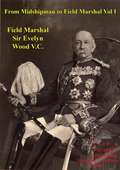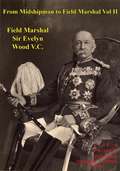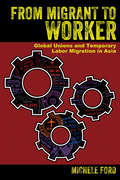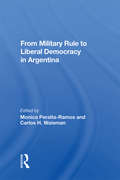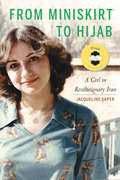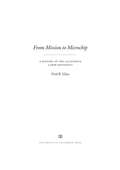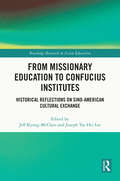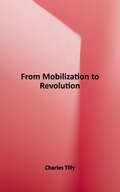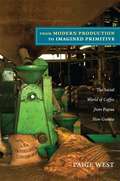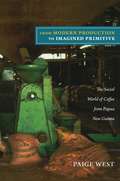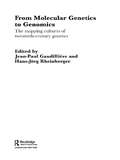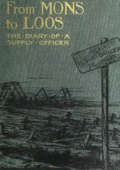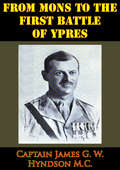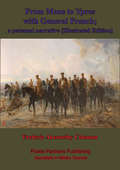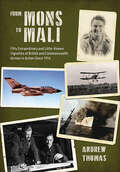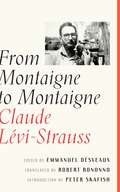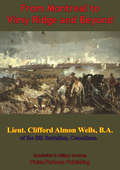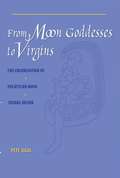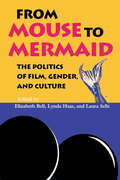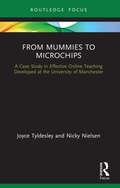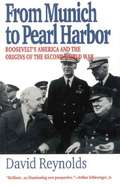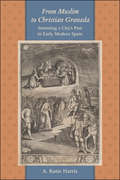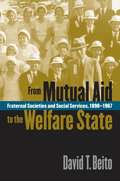- Table View
- List View
From Midshipman To Field Marshal – Vol. I (From Midshipman To Field Marshal #1)
by Field Marshal Sir Evelyn Wood V.C. G.C.B., G.C.M.G.Autobiographies come in many shapes and forms, particularly those of the military genre. In this two-volume work, Field-Marshal Wood charts his remarkable career from the Navy to the highest rank in the British Army with wit, verve, honesty and no little depreciation. He served with distinction in the mud and misery of the Crimean War, the Indian Mutiny, Wolseley's Ishanti War, the Zulu War and in Egypt and the Sudan. His actions on attacking a gang of robbers intent on murdering a local merchant earned him the Victoria Cross - his second recommendation for the V.C. A man of considerable self-taught talents (he ran away from school), upright and forthright and of great personal courage, he survived multiple wounds during his military career to reach the pinnacle of rank. He was greatly concerned with the welfare of his troops and was at the forefront of the reforms that were to ensure the British Army's success in the First World War.Author -- Field Marshal Sir Evelyn Wood V.C. G.C.B., G.C.M.G., 1838-1919Text taken, whole and complete, from the edition published in London : Methuen & co., 1906.Original Page Count - xiv and 322 pages.Illustrations -- numerous maps and plans
From Midshipman To Field Marshal – Vol. II (From Midshipman To Field Marshal #2)
by Field Marshal Sir Evelyn Wood V.C. G.C.B., G.C.M.G.Autobiographies come in many shapes and forms, particularly those of the military genre. In this two-volume work, Field-Marshal Wood charts his remarkable career from the Navy to the highest rank in the British Army with wit, verve, honesty and no little depreciation. He served with distinction in the mud and misery of the Crimean War, the Indian Mutiny, Wolseley's Ishanti War, the Zulu War and in Egypt and the Sudan. His actions on attacking a gang of robbers intent on murdering a local merchant earned him the Victoria Cross - his second recommendation for the V.C. A man of considerable self-taught talents (he ran away from school), upright and forthright and of great personal courage, he survived multiple wounds during his military career to reach the pinnacle of rank. He was greatly concerned with the welfare of his troops and was at the forefront of the reforms that were to ensure the British Army's success in the First World War.Author -- Field Marshal Sir Evelyn Wood V.C. G.C.B., G.C.M.G., 1838-1919Text taken, whole and complete, from the edition published in London : Methuen & co., 1906.Original Page Count - 322 pages.Illustrations -- numerous maps and plans
From Migrant to Worker: Global Unions and Temporary Labor Migration in Asia
by Michele FordWhat happens when local unions begin to advocate for the rights of temporary migrant workers, asks Michele Ford in her sweeping study of seven Asian countries? Until recently unions in Hong Kong, Japan, Malaysia, Singapore, South Korea, Taiwan, and Thailand were uniformly hostile towards foreign workers, but Ford deftly shows how times and attitudes have begun to change. Now, she argues, NGOs and the Global Union Federations are encouraging local unions to represent and advocate for these peripheral workers, and in some cases succeeding.From Migrant to Worker builds our understanding of the role the international labor movement and local unions have had in developing a movement for migrant workers' labor rights. Ford examines the relationship between different kinds of labor movement actors and the constraints imposed on those actors by resource flows, contingency, and local context. Her conclusions show that in countries—Hong Kong, Malaysia, and Thailand—where resource flows and local factors give the Global Union Federations more influence local unions have become much more engaged with migrant workers. But in countries—Japan and Taiwan, for example—where they have little effect there has been little progress. While much has changed, Ford forces us to see that labor migration in Asia is still fraught with complications and hardships, and that local unions are not always able or willing to act.
From Military Rule To Liberal Democracy In Argentina
by Monica Peralta-ramosArgentina has most of the characteristics that various theories of democracy postulate as prerequisites for achieving liberal democracy: an urban industrial economy, key economic resources under domestic control, the absence of a peasantry, the absence of ethnic or religious cleavages, relatively high levels of education, strong interest groups, an
From Miniskirt to Hijab: A Girl in Revolutionary Iran
by Jacqueline SaperJacqueline Saper, named after Jacqueline Kennedy, was born in Tehran to Iranian and British parents. At eighteen she witnessed the civil unrest of the 1979 Iranian revolution and continued to live in the Islamic Republic during its most volatile times, including the Iran-Iraq War. In a deeply intimate and personal story, Saper recounts her privileged childhood in prerevolutionary Iran and how she gradually became aware of the paradoxes in her life and community—primarily the disparate religions and cultures. In 1979 under the Ayatollah regime, Iran became increasingly unfamiliar and hostile to Saper. Seemingly overnight she went from living a carefree life of wearing miniskirts and attending high school to listening to fanatic diatribes, forced to wear the hijab, and hiding in the basement as Iraqi bombs fell over the city. She eventually fled to the United States in 1987 with her husband and children after, in part, witnessing her six-year-old daughter’s indoctrination into radical Islamic politics at school. At the heart of Saper’s story is a harrowing and instructive tale of how extremist ideologies seized a Westernized, affluent country and transformed it into a fundamentalist Islamic society.
From Mission to Microchip: A History of the California Labor Movement
by Fred GlassThere is no better time than now to consider the labor history of the Golden State. While other states face declining union enrollment rates and the rollback of workers' rights, California unions are embracing working immigrants, and voters are protecting core worker rights. What's the difference? California has held an exceptional place in the imagination of Americans and immigrants since the Gold Rush, which saw the first of many waves of working people moving to the state to find work. From Mission to Microchip unearths the hidden stories of these people throughout California's history. The difficult task of the state's labor movement has been to overcome perceived barriers such as race, national origin, and language to unite newcomers and natives in their shared interest. As chronicled in this comprehensive history, workers have creatively used collective bargaining, politics, strikes, and varied organizing strategies to find common ground among California's diverse communities and achieve a measure of economic fairness and social justice. This is an indispensible book for students and scholars of labor history and history of the West, as well as labor activists and organizers.
From Missionary Education to Confucius Institutes: Historical Reflections on Sino-American Cultural Exchange (Routledge Research in Asian Education)
by Joseph Tse-Hei Lee Jeff Kyong-McClainFrom Missionary Education to Confucius Institutes examines the history and globalization of cultural exchange between the United States and China and corrects many myths surrounding the incompatibility of American and Chinese cultures in the higher education sphere. Providing a fresh look at the role of non-state actors in advancing Sino-American cross-cultural knowledge exchange, the book presents empirical studies highlighting the diverse experiences and practices involved. Case studies include the U.S.-initiated missionary education in modern China, the involvement of private foundations and professional associations in education, the impact of Chinese and American laws on student exchanges, and the evaluation of the experience of U.S. Confucius Institutes. This book will appeal to students and scholars of U.S. and Chinese higher education from the past to the present, as well as international admission officers and university executives who are concerned about the global educational partnership with China and questions around the internationalization of education more broadly.
From Mobilization to Revolution
by Charles TillyFrom Mobilization to Revolution thoroughly examines the ways people act together in pursuit of common interests. Throughout, the book presents and applies various political process models for the analysis of collective action. Historical and contemporary experiences from around the world illustrate the recurrent theme of the interplay between big structural changes - state-making, expansion of capitalism, urbanization, industrialization, and electoral politics - and the collective action of ordinary people, from demonstrations and brawls to strikes and revolutions. Dr Tilly compares the competing intellectual traditions of Marx, Weber, Durkheim, and Mill, and frequently clarifies the discussion with schematic diagrams of the arguments. In addition, he offers practical guidelines for new research and advanced study aimed at senior and graduate students of political sociology, social movements, collective behavior, and political developments.
From Models to Simulations (History and Philosophy of Technoscience)
by Franck VarenneThis book analyses the impact computerization has had on contemporary science and explains the origins, technical nature and epistemological consequences of the current decisive interplay between technology and science: an intertwining of formalism, computation, data acquisition, data and visualization and how these factors have led to the spread of simulation models since the 1950s. Using historical, comparative and interpretative case studies from a range of disciplines, with a particular emphasis on the case of plant studies, the author shows how and why computers, data treatment devices and programming languages have occasioned a gradual but irresistible and massive shift from mathematical models to computer simulations.
From Modern Production to Imagined Primitive: The Social World of Coffee from Papua New Guinea
by Paige WestIn this vivid ethnography, the author tracks coffee as it moves from producers in Papua New Guinea to consumers around the world.
From Modern Production to Imagined Primitive: The Social World of Coffee from Papua New Guinea
by Paige WestIn this vivid ethnography, Paige West tracks coffee as it moves from producers in Papua New Guinea to consumers around the world. She illuminates the social lives of the people who produce coffee, and those who process, distribute, market, and consume it. The Gimi peoples, who grow coffee in Papua New Guinea's highlands, are eager to expand their business and social relationships with the buyers who come to their highland villages, as well as with the people working in Goroka, where much of Papua New Guinea's coffee is processed; at the port of Lae, where it is exported; and in Hamburg, Sydney, and London, where it is distributed and consumed. This rich social world is disrupted by neoliberal development strategies, which impose prescriptive regimes of governmentality that are often at odds with Melanesian ways of being in, and relating to, the world. The Gimi are misrepresented in the specialty coffee market, which relies on images of primitivity and poverty to sell coffee. By implying that the "backwardness" of Papua New Guineans impedes economic development, these images obscure the structural relations and global political economy that actually cause poverty in Papua New Guinea.
From Molecular Genetics to Genomics: The Mapping Cultures of Twentieth-Century Genetics (Routledge Studies in the History of Science, Technology and Medicine)
by Hans-Jörg Rheinberger Jean-Paul GaudillièreWith the rise of genomics, the life sciences have entered a new era. Maps of genomes have become the icons for a comprehensive knowledge of the organism on a previously unattained level of complexity, and the organisation of genetic knowledge in maps has been a major driving force in the establishment of the discipline. This book provides a comprehensive history of molecular genetics and genomics.The first section of the book shows how the genetic cartography of classical genetics was linked to the molecular analysis of gene structure through the introduction of new model organisms such as bacteria and through the invention of new experimental tools such as gene transfer. The second section addresses the moral and political economy of human genome sequencing in all its technical, epistemic, social and economic complexity.With detailed analyses of the scientific practices of mapping and its illustration of the diversity of mapping practices this book is a significant contribution to the history of genetics. A companion volume from the same editors - Classical Genetic Research and Its Legacy: The Mapping Cultures of Twentieth Century Genetics - covers the history of mapping procedures as they were developed in classical genetics.
From Mons To Loos - The Diary Of A Supply Officer [Illustrated Edition]
by Major Herbert A. StewartIncludes with 21 illustrations and photos.A member of General French's "Contemptible" little army recounts his tales of the opening two years of the First World War. Under shot and shell in the front lines with the gallant Tommies of the BEF from the first engagements until the bloody battle of Loos."THIS little work does not profess to be a record of historical facts, but merely a series of impressions snap-shotted upon my mind as they occurred, and set down here in simple language; and if these snapshots can bring home to my readers some idea, however faint, of what war and its attendant miseries mean, then my labour will not have been in vain."To those who may imagine that the British fighting man of to-day is not the equal of his forebears, who fought from Crécy and Agincourt to Albuera and Waterloo, I trust the story of Mons, the Aisne, Neuve Chapelle, and Ypres will set all doubts at rest."STEWART, HERBERT ARTHUR, Major, was born 18 May, 1878, and was commissioned from the Militia 4 Jan. 1899, in the Suffolk Regt., from which he was transferred to the Army Service Corps 12 Feb. 1900. Capt. Stewart served in the South African War, 1899-1902, he received the Queen's Medal with three clasps, and the King's Medal with two clasps. He was Adjutant, Territorial Force, 1 Aug. 1911, to 31 July, 1914. He again saw active service in the European War from Aug. 1914, to the conclusion of hostilities, becoming Major the day war broke out. He was one of the very few British officers who entered Mons on Sunday, 23 Aug. 1914. For his services with the 3rd Division during the First Battles of Neuve Chapelle and Ypres in Oct. and Nov. 1914, he received a D.S.O. awarded "for services in connection with operations in the field."
From Mons To The First Battle Of Ypres [Illustrated Edition]
by Captain James G. W. Hyndson M.C.Includes The First World War On The Western Front 1914-1915 Illustrations Pack with 101 maps, plans, and photos.An exceptional and vivid account of the opening battles of the First World War with the B.E.F.. Captain Hyndson was with the Loyal North Lancashire Regiment during the retreat from Mons until the First Battle of Ypres during which he was wounded and invalided back to Blighty. In recognition of his bravery he was awarded the Military Medal in 1915."As there has as yet been published no connected account of the first phase of the Great War from a Regimental Officer's point of view, I have been persuaded to put into book form the diary which I began on the first day of mobilization and kept up until I was invalided home from the French Front in 1915. As far as I am aware, there are only three or four platoon and company commanders still living who went through the Battle of, and Retreat from, Mons, as well as the Battles of the Marne, the Aisne and Ypres. This fact has emboldened me to add one more book to the already enormous bulk of war literature.It is also my desire to place on record the wonderful devotion to duty and the sterling fighting qualities of the men of Lancashire Nulli Secundus."- The Author.
From Mons To Ypres With General French; A Personal Narrative [Illustrated Edition]
by Frederic Abernethy ColemanWhen the British troops advanced into Belgium in 1914 to face the German foe, it was with a sure and steady confidence in the outcome. These same men trudged back, grumbling, along the same path toward France as the full weight of the German steamroller advanced toward the numerically small British Expeditionary Force. At Mons they turned at bay and gave the Germans a tough time, but little more than a check as two corps could not hold up two huge armies. As the static battlelines began to coalesce, from Switzerland to the English channel, the fierce fighting flared up for any advantageous town, and none more so than Ypres. The first battle of Ypres was a bitter, bloody affair which ended the German advance but at terrible cost to the last of the regular soldiers of the B.E.F.Along with these hardened professional soldiers went a handful of amateurs determined to help; these members of the Royal Automobile Club with their motor cars were attached to various headquarters to aid in transmission of orders. As the eyes and ears of the army, the two cavalry brigade were in need of the most help from the R.A.C. volunteers as they ranged far and wide. The author was attached to the cavalry during retreat from Mons to the first battle of Ypres; he admired and had grown fond of the men with whom he had shared much danger. His post enabled him to meet a great number of the high-ranking officers, and in his capacity as messenger would have been better informed than most. His book is excellently written and deserves reading and re-reading.Author -- Frederic Abernethy Coleman 1876-1931Text taken, whole and complete, from the edition published in New York, Dodd, Mead and company, 1916.Original Page Count - xvii and 381 pages.Illustrations - 50 illustrations.
From Mons to Mali: Fifty Extraordinary and Little-Known Vignettes of British and Commonwealth Airmen in Action since 1914
by Andrew ThomasAcclaimed author Andrew Thomas has chosen fifty fascinating cameos of individual actions or incidents across a wide variety of major and minor campaigns and scenarios ranging from the First World War to the present day. Each selection is accompanied by relevant, often rare, photographs. So, from the Battle of Mons in 1914 through shooting down a Zeppelin over Teeside, to WW2 Timor Ace ‘Butch’ Gordon in his Beaufighter in 1943 and a nightmare for Halifaxes over Nuremburg in 1944, to SAAF fighters over Angola in September 1985 and army support tasks in Mali in 2021, with many more in between, the author’s hand-picked personal choices make for gripping reading. A must for all those interested in the war in the air throughout history.
From Montaigne to Montaigne
by Claude Lévi-StraussTwo previously unpublished lectures charting the renowned anthropologist&’s intellectual engagement with the sixteenth-century French essayist Michel de Montaigne In January 1937, between the two ethnographic trips he would describe in Tristes Tropiques, Claude Lévi-Strauss gave a talk to the Confédération générale du travail in Paris. Only recently discovered in the archives of the Bibliothèque national de France, this lecture, &“Ethnography: The Revolutionary Science,&” discussed the French essayist Michel de Montaigne, to whom Lévi-Strauss would return in remarks delivered more than a half-century later, in the spring of 1992. Bracketing the career of one of the most celebrated anthropologists of the twentieth century, these two talks reveal how Lévi-Strauss&’s ethnography begins and ends with Montaigne—and how his reading of his intellectual forebear and his understanding of anthropology evolve along the way.Published here for the first time, these lectures offer new insight into the development of ethnography and the thinking of one of its most important practitioners. Essays by Emmanuel Désveaux, who edited the original French volume De Montaigne à Montaigne, and Peter Skafish expand the context of Lévi-Strauss&’s talks with contemporary perspectives and commentary.
From Montreal To Vimy Ridge And Beyond; The Correspondence Of Lieut. Clifford Almon Wells, B.A.,: Of The 8th Battalion, Canadians, B.E.F., November, 1915-April, 1917
by Lieutenant Clifford Almon WellsClifford Almon Wells was born in Toronto, Canada, March 12th, 1892. His teaching career at Johns Hopkins University was bought to a end when he decided in the summer of 1915 that it was his duty to relinquish his position and take his part as a Canadian in the European war. In Sep. he enlisted as a Private in the 4th University Company, one of the reinforcing companies of the famous Princess Patricia's Canadian Light Infantry. Although without previous military training his advancement was rapid, later he was transferred to the 8th Battalion as 2nd Lieutenant.His letters cover a period of eighteen months. They were written in railway cars and on board ship; in tents in England, Belgium and France; in huts, shacks, furnace rooms and ruined houses; in London boarding houses and hotels; in French farm-houses, and German dugouts; in the midst of the awful clamors and crashings and thunders of artillery, and within sound of the coughing of a sick German in the front line of enemy trenches.He wrote of things which others have written about; of things which pleased him, and of other things which displeased him, most of these relating to the commonplace of life. But in addition to the commonplace there will be found in these letters a surprising variety of topics, and withal such graphic descriptions, thrilling or amusing stories, and information on many matters of interest to all who have friends overseas that the letters will both entertain and enlighten.His last dated letter was written the 20th day of April, 1917, eleven days after the battle of Vimy Ridge. Thankful because he had had a part in that battle, exultant and confident in view of the great victory, but before this letter reached her she had received official notice that he had been killed in action the 28th day of April.
From Moon Goddesses to Virgins: The Colonization of Yucatecan Maya Sexual Desire
by Pete SigalFor the preconquest Maya, sexuality was a part of ritual discourse and performance, and all sex acts were understood in terms of their power to create, maintain, and destroy society. As postconquest Maya adapted to life under colonial rule, they neither fully abandoned these views nor completely adopted the formulation of sexuality prescribed by Spanish Catholicism. Instead, they evolved hybridized notions of sexual desire, represented in the figure of the Virgin Mary as a sexual goddess, whose sex acts embodied both creative and destructive components.<P><P>This highly innovative book decodes the process through which this colonization of Yucatan Maya sexual desire occurred. Pete Sigal frames the discussion around a series of texts, including the Books of Chilam Balam and the Ritual of the Bacabs, that were written by seventeenth and eighteenth century Maya nobles to elucidate the history, religion, and philosophy of the Yucatecan Maya communities. Drawing on the insights of philology, discourse analysis, and deconstruction, he analyzes the sexual fantasies, fears, and desires that are presented, often unintentionally, in the "margins" of these texts and shows how they illuminate issues of colonialism, power, ritual, and gender.
From Moscow to Stalingrad: The Eastern Front, 1941-1942 (Casemate Illustrated #Cis0005)
by Yves BuffetautA concise and entertaining history of the Roman legionary—from the age of Augustus through the heyday of the Roman Empire.The might of Rome rested on the back of its legions; the superbly trained and equipped fighting force with which the imperial Roman army conquered, subdued and ruled an empire for centuries. The legionary soldier served for 20 years, was rigorously trained, highly equipped, and motivated by pay, bonuses and a strong sense of identity and camaraderie. Legionaries wore full body-armor and carried a shield, as well as two javelins, a sword, and a dagger. In battle they hurled their javelins and then immediately drew their swords and charged to close combat with the enemy. They were the finest heavy infantrymen of antiquity, and a massed legionary charge was a fearsome sight.In The Roman Legionaries, Simon Elliott, author of Julius Caesar: Rome’s Greatest Warlord, provides an introduction to these elite soldiers, including their training, tactics, weapons, the men themselves, life on and off the battlefield, as well as significant triumphs and disasters in the great battles of the era.
From Mouse to Mermaid: The Politics of Film, Gender, and Culture
by Elizabeth Bell, Lynda Haas, Laura SellsA collection of essays that explicate Disney ideology through fifty-five years of feature films, including Bambi, Beauty and the Beast, Pinocchio, and more.From Mouse to Mermaid, an interdisciplinary collection of original essays, is the first comprehensive, critical treatment of Disney cinema. Addressing children’s classics as well as the Disney affiliates’ more recent attempts to capture adult audiences, the contributors respond to the Disney film legacy from feminist, marxist, poststructuralist, and cultural studies perspectives. The volume contemplates Disney’s duality as an American icon and as an industry of cultural production, created in and through fifty years of filmmaking. The contributors treat a range of topics at issue in contemporary cultural studies: the performance of gender, race, and class; the engendered images of science, nature, technology, family, and business. The compilation of voices in From Mouse to Mermaid creates a persuasive cultural critique of Disney’s ideology.The contributors are Bryan Attebery, Elizabeth Bell, Claudia Card, Chris Cuomo, Ramona Fernandez, Henry A. Giroux, Robert Haas, Lynda Haas, Susan Jeffords, N. Soyini Madison, Susan Miller, Patrick Murphy, David Payne, Greg Rode, Laura Sells, and Jack Zipes.“In this volume of 16 essays about Disney films, several pieces . . . begin the work of filling in a major gap in our understanding of animation.” —Film Quarterly
From Mummies to Microchips: A Case-Study in Effective Online Teaching Developed at the University of Manchester
by Joyce Tyldesley Nicky NielsenThis volume offers a detailed case study of the internationally acclaimed online programmes in Egyptology at the University of Manchester, UK. It distils over a decade of online teaching experience and student feedback, providing guidance for instructors developing their own online offerings. Today, many universities are actively encouraging their teaching staff towards the development of: • online programmes (programmes to be taught entirely online) and/or • online units (units to be incorporated into “blended” programmes taught partially online and partially face-to-face). Unfortunately, the staff tasked with the development of online learning rarely have access to the expertise that they need to help them utilise their teaching skills to their full potential. Technical assistance may be provided by the university e-learning department, but pedagogical and practical help – the support of colleagues with many years’ experience teaching online – is lacking. Written by experts, the book provides an invaluable guide for those wishing – or being compelled – to establish their own online courses within the humanities.
From Munich To Pearl Harbor: Roosevelt's America And The Origins Of The Second World War (American Ways Series)
by David ReynoldsFour years before Pearl Harbor, the United States had turned in on itself, mired in the Great Depression and fearing entanglement in another European war. Four years after Pearl Harbor, it accounted for half the world's economic output and boasted a navy and air force second to none. The period from 1938 to 1941, David Reynolds argues in his brilliant new book, was a turning point in modern American history. Drawing upon his own research and the latest scholarship, Mr. Reynolds shows how Franklin Roosevelt led Americans into a new global perspective on foreign policy, one based on geopolitics and ideology. FDR insisted that in an age of airpower, U.S. security required allies far beyond the Western Hemisphere, and that in an era of dictatorships, American values could and should transform the world. Months before Pearl Harbor, he had popularized the term "second world war." Mr. Reynolds, in his succinct overview of American foreign policy from Munich to Pearl Harbor, shows how the president used his new perspective in responding to international shocks—the fall of France, Hitler's invasion of Russia, Japan's drive into Southeast Asia. But one of the signal accomplishments of From Munich to Pearl Harbor is also to explain how the main features of America's cold war posture (following World War II) were established in the years before the war—a new globalism, a bipolar worldview, the foundations of the military-industrial complex, and the origins of the "imperial presidency."
From Muslim to Christian Granada: Inventing a City's Past in Early Modern Spain (The Johns Hopkins University Studies in Historical and Political Science #125)
by A. Katie HarrisHonorable Mention, 2010 Best First Book, Association for Spanish and Portuguese Historical StudiesIn 1492, Granada, the last independent Muslim city on the Iberian Peninsula, fell to the Catholic forces of Ferdinand and Isabella. A century later, in 1595, treasure hunters unearthed some curious lead tablets inscribed in Arabic. The tablets documented the evangelization of Granada in the first century A.D. by St. Cecilio, the city’s first bishop. Granadinos greeted these curious documents, known as the plomos, and the human remains accompanying them as proof that their city—best known as the last outpost of Spanish Islam—was in truth Iberia’s most ancient Christian settlement. Critics, however, pointed to the documents’ questionable doctrinal content and historical anachronisms. In 1682, the pope condemned the plomos as forgeries.From Muslim to Christian Granada explores how the people of Granada created a new civic identity around these famous forgeries. Through an analysis of the sermons, ceremonies, histories, maps, and devotions that developed around the plomos, it examines the symbolic and mythological aspects of a new historical terrain upon which Granadinos located themselves and their city. Discussing the ways in which one local community’s collective identity was constructed and maintained, this work complements ongoing scholarship concerning the development of communal identities in modern Europe. Through its focus on the intersections of local religion and local identity, it offers new perspectives on the impact and implementation of Counter-Reformation Catholicism.
From Mutual Aid to the Welfare State
by David T. BeitoDuring the late nineteenth and early twentieth centuries, more Americans belonged to fraternal societies than to any other kind of voluntary association, with the possible exception of churches. Despite the stereotypical image of the lodge as the exclusive domain of white men, fraternalism cut across race, class, and gender lines to include women, African Americans, and immigrants. Exploring the history and impact of fraternal societies in the United States, David Beito uncovers the vital importance they had in the social and fiscal lives of millions of American families.Much more than a means of addressing deep-seated cultural, psychological, and gender needs, fraternal societies gave Americans a way to provide themselves with social-welfare services that would otherwise have been inaccessible, Beito argues. In addition to creating vast social and mutual aid networks among the poor and in the working class, they made affordable life and health insurance available to their members and established hospitals, orphanages, and homes for the elderly. Fraternal societies continued their commitment to mutual aid even into the early years of the Great Depression, Beito says, but changing cultural attitudes and the expanding welfare state eventually propelled their decline.
